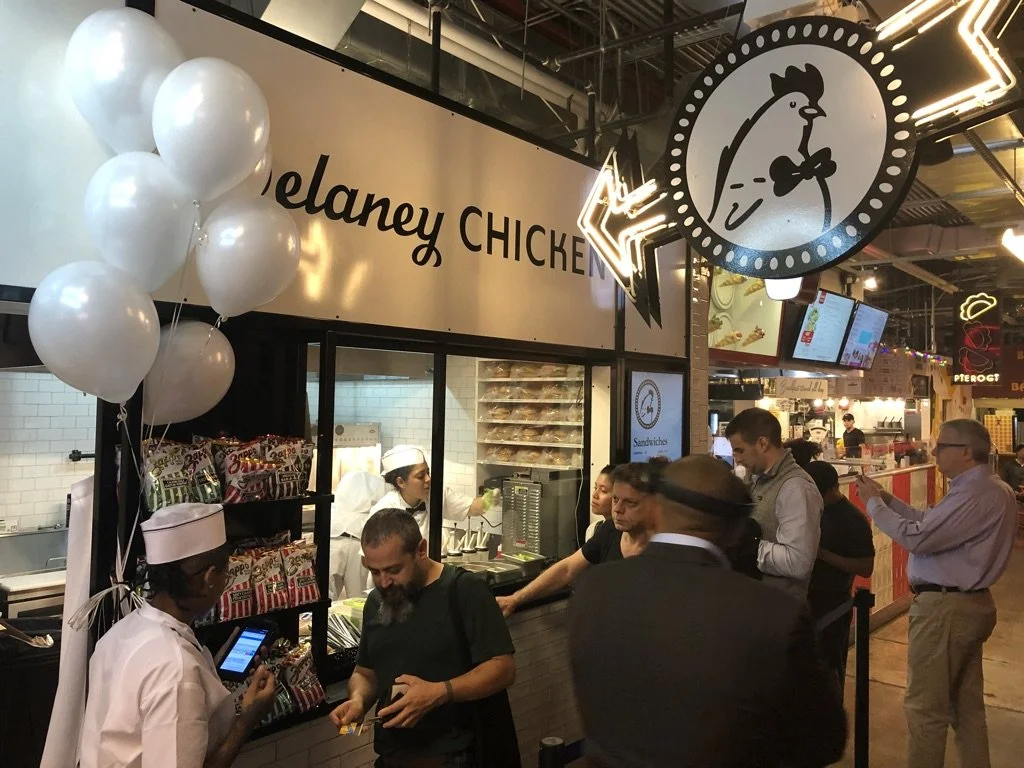
Restaurant Venture:
Delaney Chicken
What: Quick service restaurant
Where: New York City
When: 2016 - 2019
Overview
Delaney Chicken was born from both a strategic shift and a culinary obsession. Originally approached to launch an outpost of Delaney Barbecue in a Manhattan food hall, I pivoted after recognizing that barbecue—while beloved in NYC—was too heavy for daily lunch traffic. At the same time, I’d been quietly developing a fried chicken recipe inspired by New Orleans’ iconic Willie Mae’s Scotch House. It felt clear that fried chicken, while still indulgent, resonated as a more “lunchable” option. So we launched a new brand—Delaney Chicken—with a singular mission: make the best fried chicken sandwich in the city.
We opened with bone-in chicken but quickly pivoted to focus exclusively on sandwiches, responding to overwhelming demand and operational necessity. It was the right call. Chick-fil-A hadn’t yet entered the New York market, and Delaney Chicken found a massive audience of loyal, repeat customers almost immediately.
Strategy
We focused on throughput, quality, and emotional connection. By simplifying the menu and dialing in production, we built a system that could move high volumes of food at lightning speed without compromising quality. We sought to create a guest experience that was fast, frictionless, and craveable—something that could easily become a daily habit for office workers, commuters, and neighborhood locals.
Operations
Each Delaney Chicken location generated approximately $1 million in annual revenue—with a footprint of just 125–150 sq ft per stall. Labor and food costs were both kept in the high 20% range, with a lean team structure: one GM per location, and cross-trained team members who could flex across roles and sites.
We designed the system to handle volume intelligently. Two sandwich stations were created—one dedicated to our two most popular items, which made up 70%+ of orders. This allowed for tight control over freshness and timing while maximizing speed. We eliminated the traditional cashier and instead walked the line with mobile tablets, taking orders while guests queued at a single “pickup” window. Combined with our limited menu, this allowed us to hit 90-second ticket times—creating a guest journey that was unique, efficient, and remarkably smooth.
Menu
The menu at Delaney Chicken was deliberately small by design—built to emphasize speed, consistency, and quality over customization. Every sandwich started from the same foundation: a deeply marinated, batter-fried chicken thigh on a standard bun. From there, just a few precisely chosen ingredients differentiated the SKUs.
The Classic: Duke’s mayo and house-made pickles
The Spicier: Smoky, spicy mayo, Havarti, pickled jalapeños
The Ranchwich: Bacon, cheddar, and ranch mayo
The Club: Smokey bacon, herb mayo, lettuce, tomato
Each sauce was co-manufactured to our specifications, allowing us to maintain full creative control while ensuring flawless execution across locations. That intentional use of co-packing meant the system was simple by design—any team member could deliver perfect flavor replication, every time.
By locking the protein and bread, we created a menu that was tightly controlled but still emotionally rich—every sandwich distinct, yet all sharing a clear DNA. The simplicity wasn’t just aesthetic; it was operational. It minimized training, reduced prep time, and eliminated decision fatigue for both staff and guests.
Our beverage program was treated with the same logic: a short, focused list of high-margin, high-appeal options—fresh lemonade, sweet tea, and Arnold Palmers—batched daily, sealed with a bubble-tea machine for delivery. We rounded out the offering with Zapp’s chips, giving guests something familiar to pair with something cultish.
Brand Identity
Delaney Chicken’s identity was clean, classic, and considered. Designed by Drew Heffron, our logo—a friendly black-and-white chicken—was a visual sibling to Delaney Barbecue, using similar butcher-style dotted lines. Our booths mirrored the sanitary porcelain panels of early 20th-century delis like Barney Greengrass, recreated via black and white powder coating.
Staff uniforms featured black and white outfits with seasonal bowties—red at Christmas, orange for Halloween—a subtle way to evoke timelessness while staying playfully current. The brand felt like it had always existed, in the best way.
The response was overwhelming. Press and guests alike called it the best fried chicken sandwich they’d ever had. Lines stretched long and regularly. Customers returned multiple times a week, often grabbing sandwiches to take home to family—or eat on the train.
Financial Snapshot
Delaney Chicken operated in high-traffic urban food halls, using a kiosk-style footprint to drive volume and margin through smart design and operational efficiency.
Key performance indicators:
~$1M annual revenue per location
125–150 sq ft per unit → ~$8,000/sq ft in sales
27–29% labor cost
27–29% food cost
90-second average ticket time
Dual-station assembly model to streamline volume
~70% of orders from top two sandwiches
No cashier: mobile ordering during pickup queue
Daily repeat customers and multi-sandwich orders common
Fresh lemonade and tea program drove high-margin upsells
Strong delivery conversion via sealed drink packaging
Operated with minimal in-store staffing (1 GM + 2–3 cross-trained team members)
Reflections
Delaney Chicken hit incredible numbers: ~$8,000 per sq ft in sales—more than 10x Chick-fil-A’s national average. But it also revealed structural challenges. The brand had leaned on existing infrastructure from Delaney Barbecue; when that business closed, our operational efficiency took a hit. And while revenue was strong, rent—especially in food halls—was unsustainable. Our effective rent burden hit 23% once utilities and CAM fees were factored in. Despite industry-crushing revenue per sq ft, the math didn’t work long-term.
The biggest takeaway? High volume in a food hall doesn’t guarantee profitability. The model demands extreme efficiency and an almost perfect rent-to-revenue ratio. That wasn’t clear in our original modeling—and it’s something I’ll carry forward.






